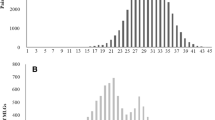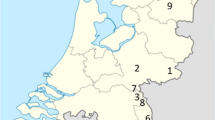Abstract
Many species in genebank collections are maintained vegetatively either as in vitro cultures or as plants in the field or greenhouse. In these cases, individual genotypes (cultivars) are the focus of conservation. In crop wild relatives, where the value of an accession is in the heterogeneity of segregating genotypes, seeds may be the most representative form of conservation. We used two sets of field-planted Malus sieversii apple trees that originated from seeds collected from two wild populations in Kazakhstan as a model system to determine if seeds from hand-pollinated crosses could be used to represent the allelic diversity of the parent trees in a genebank orchard. A crossing design was developed that used each of the selected trees from the two Kazakhstan collection sites as mothers and also as fathers in the form of bulked pollen pools. The sets of offspring from these crosses were genotyped using microsatellite markers. Paternity analyses revealed the percentage of offspring that was derived from each of the parent trees. We also determined the contribution of each parent to the fertilization events from the pollen pools. Although there were some unintended pollination events (fertilization by trees in unexpected pollen pools) and unequal contribution of pollen parents within pollen pools, we demonstrated that the seedlings effectively captured the allelic frequency and diversity of the parents. A seed collection strategy is the most efficient way to conserve the diversity of crop wild relatives even in collections typically conserved as individual clones.


Similar content being viewed by others
References
Bamberg J, Del Rio A, Moreyra R (2009) Genetic consequences of clonal versus seed sampling in model populations of two wild potato species indigenous to the USA. Am J Pot Res 86:367–372
Del Rio AH, Bamberg JB (2003) The effect of genebank seed increase on the genetics of recently collected potato (Solanum) germplasm. Am J Pot Res 80:215–218
Excoffier L, Laval G, Schneider S (2005) Arlequin ver. 3.0: an integrated software package for population genetics data analysis. Evol Bioinform Online 1:47–50
Fazio G, Aldwinckle HS, Volk GM, Richards CM, Janisiewicz WJ, Forsline PL (2009) Progress in evaluating Malus sieversii for disease resistance and horticultural traits. Acta Hort 814:59–66
Forsline PL, Aldwinckle HS (2004) Evaluation of Malus sieversii seedling populations for disease resistance and horticultural traits. Acta Hort 663:529–534
Forsline PL, Towill LE, Waddell JW, Stushnoff C, Lamboy WF, McFerson JR (1998) Recovery and longevity of cryopreserved dormant apple buds. J Am Soc Hort Sci 123:365–370
Forsline PL, Aldwinckle HS, Dickson EE, Luby JJ, Hokanson SC (2003) Collection, maintenance, characterization, and utilization of wild apples of Central Asia. Hort Rev 29:1–62
Hokanson SC, Szewc-McFadden AK, Lamboy WF, McFerson JR (1998) Microsatellite (SSR) markers reveal genetic identities, genetic diversity and relationships in a Malus × domestica Borkh. Core Subset Collect Theor Appl Genet 97:671–683
International Board for Plant Genetic Resources (1985) Long-term seed storage of major temperate fruits. Food and Agriculture Organization of the United Nations, Rome 40
Kalinowski ST, Taper ML, Marshall TC (2007) Revising how the computer program CERVUS accommodates genotyping error increases success in paternity assignment. Mol Ecol 16:1099–1106
Mariette S, Balsemin E, Stoeckel S, Tavaud M, Le Bouler H, Santi F, Verger M (2006) Parental participation in progeny and effective population sizes in experimental seed orchards of wild cherry Prunus avium L. (Batsch). Ann For Sci 64:533–539
Pollegioni P, Woeste K, Mugnozza GS, Malvolti ME (2009) Retrospective identification of hybridogenic walnut plants by SSR fingerprinting and parentage analysis. Mol Breed 24:321–335
Postman J, Hummer K, Stover E, Krueger R, Forsline P, Grauke LJ, Zee F, Ayala-Silva T, Irish B (2006) Fruit and nut genebanks in the U.S. Nat Plant Germplasm Syst HortSci 41:1188–1194
Reed BM (2001) Implementing cryogenic storage of clonally propagated plants. CryoLetters 22:97–104
Volk GM, Walters C (2003) Preservation of genetic resources in the national plant germplasm clonal collections. Plant Breed Rev 23:291–344
Volk G, Richards CM, Reilley AA, Henk AD, Forsline PL, Aldwinckle HS (2005) Ex situ conservation of vegetative propagated species: development of a seed-based core collection for Malus sieversii. J Am Soc Hort Sci 130:203–210
Walters C, Wheeler LM, Grotenhuis JM (2005) Longevity of seeds stored in a genebank: species characteristics. Seed Sci Res 15:1–20
Acknowledgments
We appreciate the assistance and feedback provided by Dr. C. Thomas Chao. Any mention of trade names of commercial products in this article is solely for the purpose of providing specific information and does not imply recommendation or endorsement by the U.S. Department of Agriculture.
Author information
Authors and Affiliations
Corresponding author
Ethics declarations
Conflict of interest
The authors declare that the research was conducted in the absence of any commercial or financial relationships that could be construed as a potential conflict of interest.
Additional information
Philip L. Forsline and Herb Aldwinckle: Retired.
Rights and permissions
About this article
Cite this article
Volk, G.M., Henk, A.D., Forsline, P.L. et al. Seeds capture the diversity of genetic resource collections of Malus sieversii maintained in an orchard. Genet Resour Crop Evol 64, 1513–1528 (2017). https://doi.org/10.1007/s10722-016-0450-8
Received:
Accepted:
Published:
Issue Date:
DOI: https://doi.org/10.1007/s10722-016-0450-8




